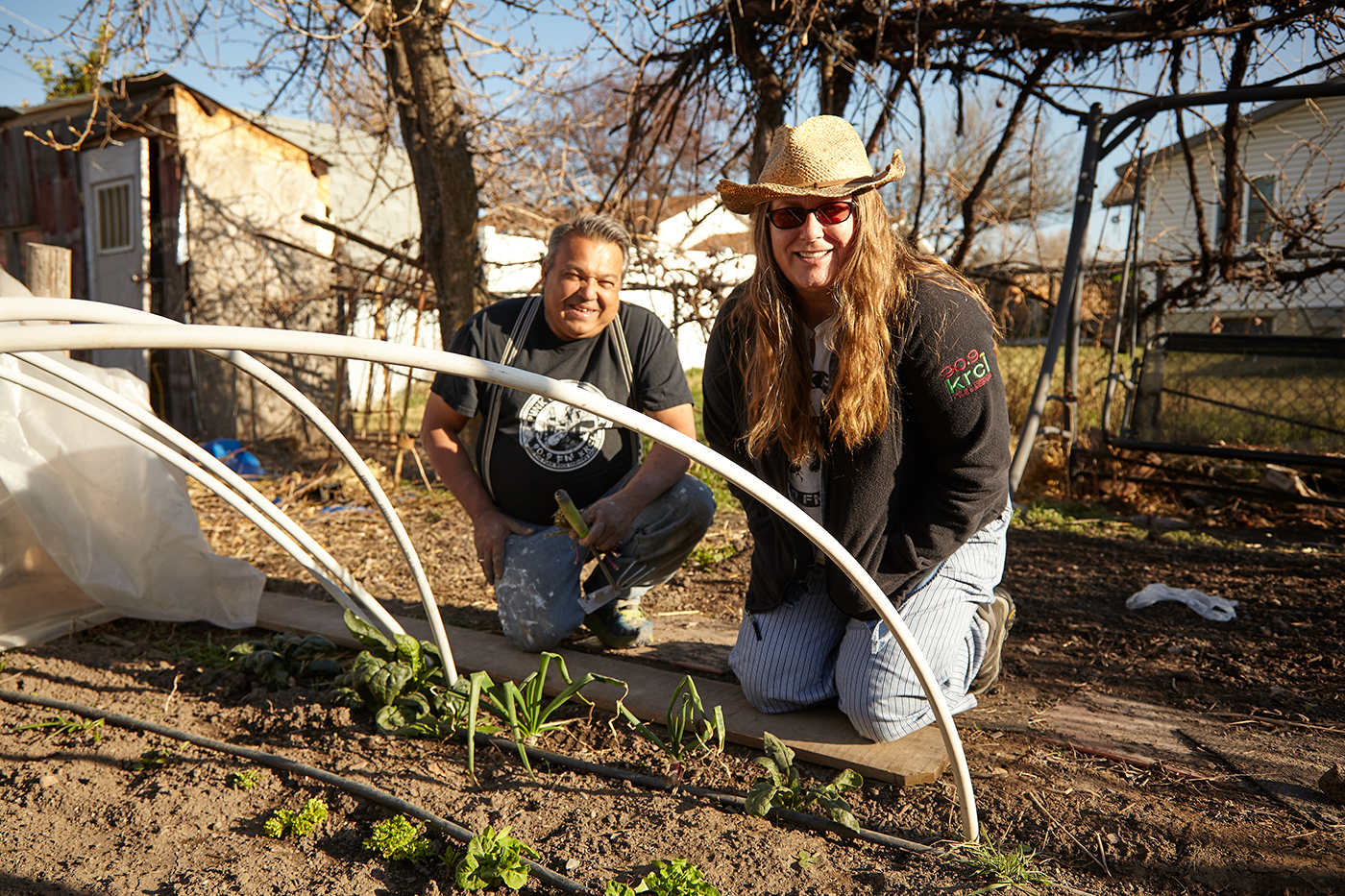
Digging in the Dirt – DIY Tips to Grow a Garden This Year
Activism, Outreach and Education
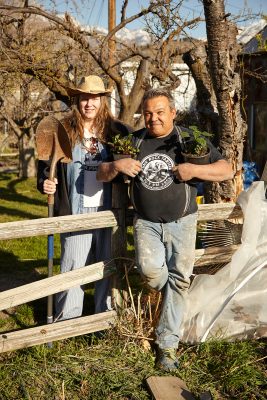
As hosts of KRCL “RadioACTive’s” “Punk Rock Farmer Friday,” “Resistance is fertile” is a phrase we picked up over the last five years exploring the agrihood—that is, agriculture plus neighborhood—of the Wasatch Front and Back. There have been politics to fight over and a pandemic to subdue, but for one hour a week, we’ve been able to talk about something everybody needs, food, and growing it in our own backyards. Depending on how you look at it, a garden is either an act of faith or a gamble—that the rains come, the bugs don’t, the harvest is plentiful and the squirrels aren’t.
Aldine grew up on a 68-acre farm in upstate New York, but when he found himself taking over his dad’s garden in Millcreek 10 years ago, he says it was like starting over. So he applied the same DIY approach to gardening that he’s always taken with music—dig in, get it done and have fun doing it. He’s been adding a couple of rows every year since, and now pulls pounds of tomatoes for sauce, bags of greens for salads and even fruit and figs for his homemade hooch.
Lara’s a farmer’s granddaughter, and her late-mother would laugh her ass off (but help her pull weeds if she could) to find her daughter tending a garden these days. As a kid, her summer-chore choices were weed the garden or clean the kitchen—and she knew which one had air conditioning. The squirrels may have gotten her squash and pumpkins last year, but the tomatoes alone mean that come mid-May and a 10-day stretch of nighttime temps above 55, she’s rolling the dice again on Blue Beauty, Cherokee Purple and Blush Tiger tomatoes.
Since joining her on “RadioACTive” in 2015 as KRCL’s Punk Rock Farmer, Al and Lara have been able to pick the brains of folks who know what they’re doing and are willing to share their know-how. We’ve asked them for some simple tips to get you growing a garden this year, too. Give it a try and be sure to send us some photos of what your agrihood looks like come harvest time. Email us at radioactive@krcl.org.
Pick your spot with James Loomis – Green Phoenix Farm, operated by Wasatch Community Gardens
Sun, water and good soil are what you need to get started. “First and foremost,” Loomis says, “we want to be on the south side of a building, if possible, and the east side is also important.” All told, your plants need at least six hours of full sun a day. “The west side—if that’s all you have—that’s fine, but it’s just going to get beat by that hot afternoon sun.”
Loomis recommends a sun audit of your spot. “[When] you’re watching that spot, see what time it comes into sun, see what time it goes into shade,” he says. “Of course, that changes with the seasons.”

For water, take note of where you have access to it. Will you be hand-watering? Sprinklers or drip? Faucet close by for a hose? The goal is to make it as easy as possible for you to be in the garden. Loomis says, “I want my garden to be somewhere I like to be and somewhere I walk through and spend time.”
For soil, Loomis says plants like evenly moist, well-drained soil. “But honestly,” he says, “you get what you get, and you don’t throw a fit. It’s an urban environment, it’s your yard—do you have some soil? High-five self, let’s grow in it. Is it nasty and rocky, maybe not the best to grow in? Well, then let’s build a garden box and let’s grow up [directionally speaking].” Pots on the deck or balcony in a sunny spot are another option.
“To me, the best benefit of gardening is just interacting with the plants,” Loomis says. “And you’re going to get a huge mental-health benefit and physical-health benefit from just tending a few pepper plants in pots on your porch. A few hot peppers go a long way—you can have some hot sauces and have something that really lasts, and that gardening experience now carries that good mojo into the wintertime.”
Pro tip: Google Earth Pro, in the layers panel, can help you track the sun. “You can actually click a little sun icon in there,” says Loomis. “Enter the date and track where that sun and shade will be at different times of the year.”
Get your tools with Katie Nelson – Executive Director of The Green Urban Lunch Box, a nonprofit that helps folks grow food in urban spaces
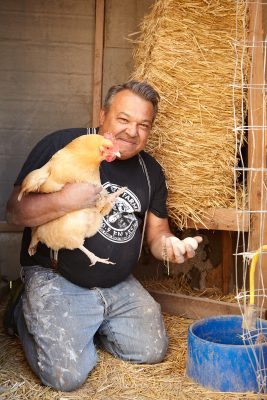
No. 1 – Shovel. “If you have a shovel, you could accomplish so much,” Nelson says. “Because not only does it dig holes and all of that stuff and get weeds out, but you can also cut stuff with a really sharp shovel—which is super handy when you’re out in the field.”
No. 2 – Gloves. After years of gardening without them—because “I really just wanted to touch the soil”—Nelson says it was cats that made her put on gloves. “I started encountering a lot of cat poop and started wearing gloves,” she says, and in an urban environment, your cats or your neighbors’ cats may love the garden just as much as you do, but for different reasons. But hey, they keep the mice population in check, so: trade-offs. Nelson recommends gloves that are breathable but have a barrier coating on the palms and fingertips for durability. She finds leather gloves too bulky and lacking the finger dexterity she wants when digging in the ground with her hands.
No. 3 – Ballcap. Maybe SLUG or KRCL trucker caps? Gotta support!
Pro tools: Nelson says, “The broadfork a super-cool tool that is used to prep the garden beds in the spring for planting. Also, we just got a tilther, another very cool tool that is ‘low till’ and only churns up the top couple of inches of soil for planting. It leaves the remainder of the soil intact and doesn’t disturb the soil biology and all the microorganisms in the soil, so it’s great for soil health.”
Get It in the Ground: Seeds vs. Starts
Seeds with Joseph Lofthouse – Lofthouse is a landrace gardening expert from Paradise, Utah, who will publish Landrace Gardening, Food Security Through Biodiversity and Promiscuous Pollination later this spring
“One thing to know about seeds is that seeds love to grow,” says Joseph Lofthouse, of Paradise, Utah, where he’s been refining his theory of promiscuous pollination to simplify gardening and seed saving. “For the most part, if we put them in the ground and give them some water, they’re going to grow, and we just have to stay out of the way.”
Once you’ve picked your spot, pulled out competing weeds or plants and mixed in some good compost (homegrown or store-bought), get those seeds in the ground. Unlike plant starts, seeds mean never having to worry about root balls or hardening off techniques. Follow directions on the seed packet for when to plant, how deep and how far apart. Don’t forget to tamp down the earth over your seeds.
“My experience is that the seeds really need to be tamped down so they have firm contact between the soil and the seed, so the moisture of the soil can get into the seed,” Lofthouse says. Tamping also helps to keep the seeds away from birds and varmints (more on varmints later).
Pro-tip: There are seeds—such as carrots, peas and beans—that will sprout a lot quicker if you soak them in water overnight or for a few hours in the morning before planting. Place them in a container with just enough water to cover them. “Plant them wet,” Lofthouse says, “and that can help them to germinate quicker and more reliably.”
Starts with Marybeth Janerich – Community Education Director for Wasatch Community Gardens
Starts are baby plants. Marybeth Janerich picks all the seeds that Wasatch Community Gardens grows at The Green Team Farm for its annual Spring Plant Sale. She suggests that backyard or balcony gardeners pick starts based on what you’d like to eat all summer long.
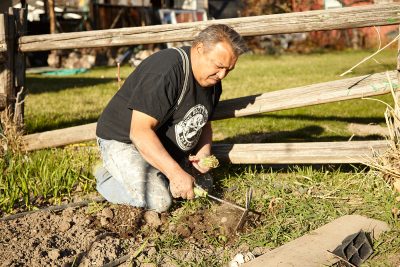
“For example, if you want cucumbers, do you want them for fresh eating or do you want pickling cucumbers?” Janerich says. “If you’re looking for tomatoes, do you want cherries for just popping into your mouth? Do you want sauce or paste tomatoes for maybe canning or making spaghetti sauce, or like a thick chunky salsa? Or do you want tomatoes for a BLT or a grilled cheese and tomato sandwich?” Basically, plant for your appetite.
Regardless of the variety, don’t bring home a plant that looks unhealthy: “It should be a rich-green color, it should not have brown spots, [and] it shouldn’t have yellow, dead leaves on it.” Many tomato growers swear by Mother’s Day as the time to put your baby plants in the group. Janerich swears by forecasts from NOAA, the National Oceanic and Atmospheric Administration. Around the first or second week of May, she says, the trick is to find a 10-day run when nighttime lows are consistently over 55 degrees. “By that point, you can pretty well guarantee your soil temperature is going to be at a sufficient level that the plants’ roots won’t get shocked.”
When planting your starts, you generally plant them as deep as the container they came in, but twice as wide. If they’re fresh out of a climate-controlled greenhouse, you will want to harden them off over the course of a week by gradually exposing them to their new spot more each day before putting them into the ground.
Janerich says not to tamp starts into place like seeds. “Newer research shows that rather than pressing it down with your hands, it’s better for the roots of the plant to actually water it into place, and [that] water and that process of water going through the soil, with gravity and seepage, is actually better than using your hands to squish out the air.”
Want more tips from Janerich? Click here for a ton of online videos and have at it.
Pro tip: To protect your plants from sunscald during summer’s high temps and long sunny days, Janerich recommends 30% shade cloth. How do you know where to put the shade cloth and when? “You can actually stand in your garden at 3:30, 4 in the afternoon in August and be like, ‘Where would I want to be standing in relation to the shade cloth,’” says MB. “Where would you be most comfortable? That’s where your plant will be most comfortable.”
Fighting weeds and wabbits with Katie Wagner – Horticultural Faculty, USU Extension – Salt Lake County
Expect and anticipate weeds. “It’s not if it’s going to become a problem; it’s when it’s going to become a problem,” Wagner says. Whether weed, flower or vegetable, all seeds need the same thing to germinate: the right soil temperature, light, soil and water—all things that a gardener can work to control.
In fact, she says that right now is when you can do a lot to reduce weed pressure later in the growing season. Just like the annual and perennial flowers you plant in your yard, weeds, too, have different life cycles. “So as we see those [weeds] starting to come up in the garden, we definitely want to be tackling those things now.”
Pre-emergent treatments—read: chemicals—can be useful, but Wagner recognizes that many backyard gardeners want less toxic options around plants that will later end up on their dinner table. She recommends keeping the soil surface covered with mulch, newspaper or cardboard once your plants are in the ground. Then, you should make a plan to spend time each day plucking the weeds while they’re still manageable. “Hand-pulling, as tedious as it may be, is extremely easy when they’re just little teeny-tiny seedlings, and you don’t get a lot of disturbance when you’re trying to pull them out of the ground.”
For wabbits and other varmints, Wagner recommends trapping, especially in urban areas. “There are a lot of things that like to eat our gardens, including us,” she says. “I think people do need to be very conscientious when setting out toxic baits. They can be quite effective, but after the rat or whatever it is that’s being targeted dies, there are other things that can come along and consume that carcass and can get access to the toxins as well. So it’s much better to live-trap, if possible.”
Pro tip: USU Extension offers free and low-cost garden education, including an online library of how-to videos from Utah State University faculty and Extension folks. Click here to sign up for the SL County extension office’s monthly newsletter.
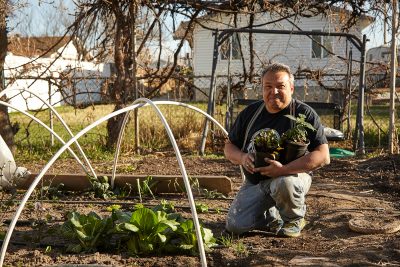
Harvest with Alison Einerson – Executive Director of Urban Food Connections of Utah, which runs the Downtown SLC Farmers Market
Just like Janerich, Einerson plants her garden based on what she wants to eat through the winter. If you want pickles in December, plant cucumbers in May, says Einerson, who gets her starts from Wasatch Community Gardens. This year she chose Boston and National starts to plant. “I’ve got my picklers, I’ve got my slicers, and then I’ve got a selection of tomatoes that can really well.” Her go-to tomatoes: San Marzano Redorta, which she cans for soups and stews all winter; Dr. Wyche’s Yellow Heirloom and Kelloggs Breakfast, which she mixes with some red heirlooms for a jar that’s as pretty on the shelf as its contents are tasty in chili come January.
Pro tip: Frozen herb cubes. At the end of the growing season but before the first frost of the fall, harvest your remaining herbs. In a food processor, place herbs and water, eyeball it to your desired consistency, then pour into ice cube trays. Store the flavorful cubes in a freezer-safe bag, then add to soups and stews all winter long.
FYI: Winter Farmers Market at The Gateway, which ends April 17, and Summer Market at Pioneer Park opening June 5. Look for the quick pickle, aka “Quickle,” during Eat Local Week in September. “That’s a really fun event where you just shop the market, buy what you want, and then we provide you with three different kinds of brine,” Einerson says. “You cut it up and put it in jars right then. Those are not shelf-stable pickles, but they’ll last in your fridge for a very long time. I still have a jar in my fridge from last year.”
Local Musician Aldine Strychnine (House of Cards, Maimed for Life, Homo Leviticus) became KRCL’s Punk Rock Farmer in 2015. Al and Lara Jones bring you true tales of the agrihood and fresh, homegrown music when they host RadioACTive Friday nights at 6 p.m. on 90.9fm in SLC, Utah, or globally at krcl.org.
